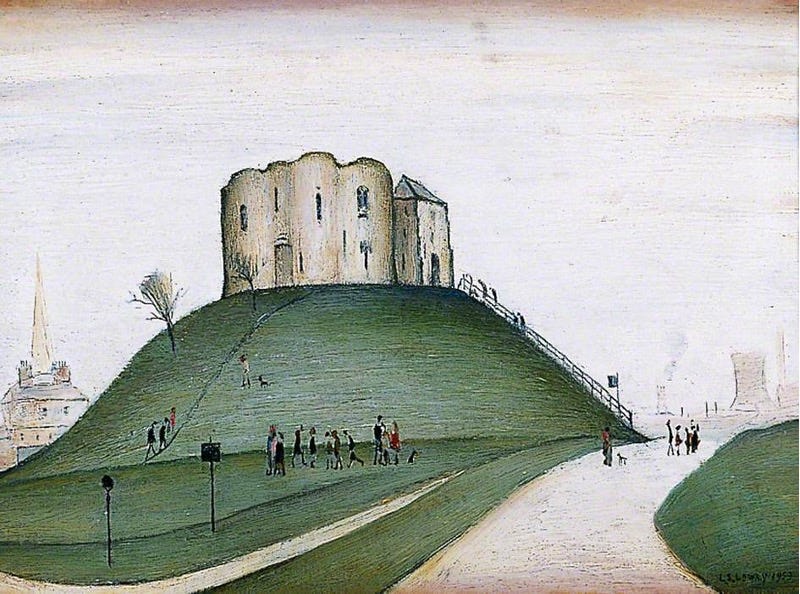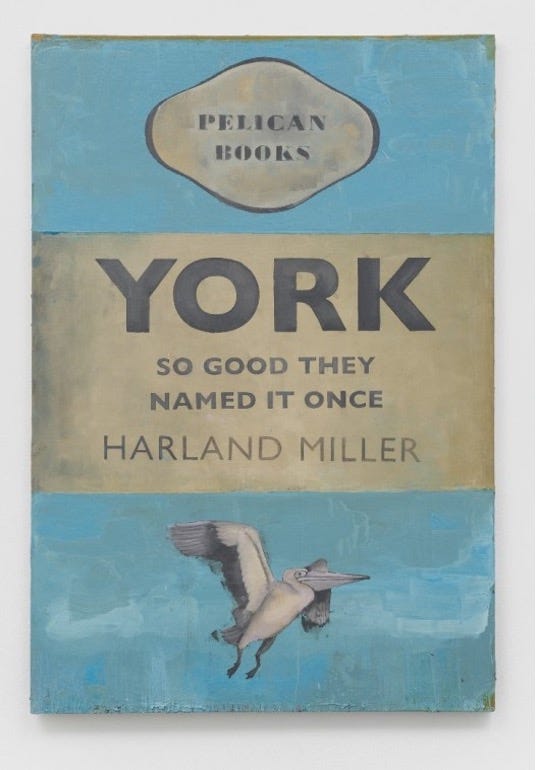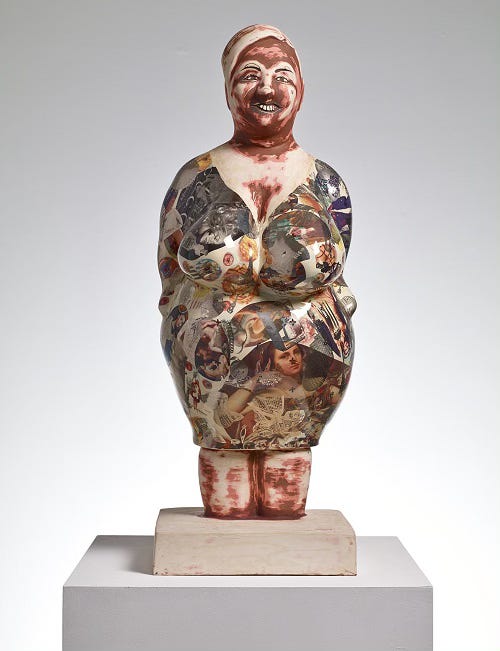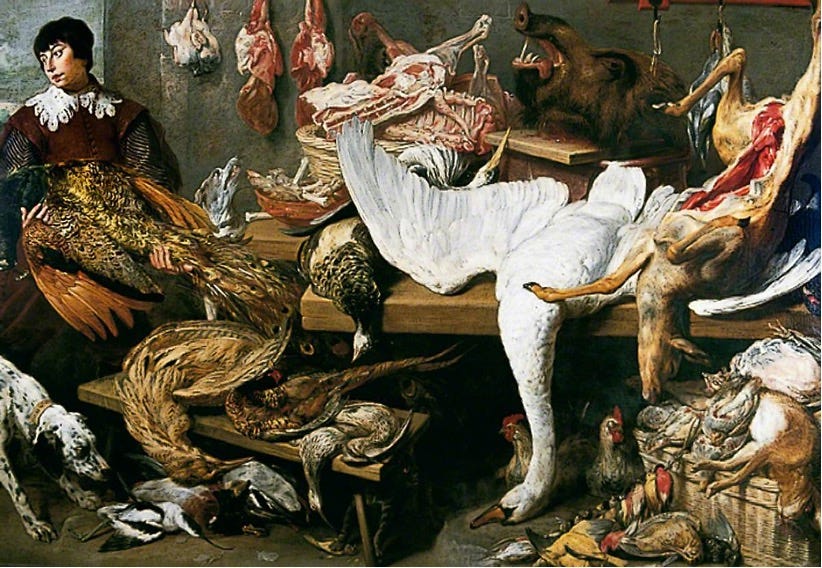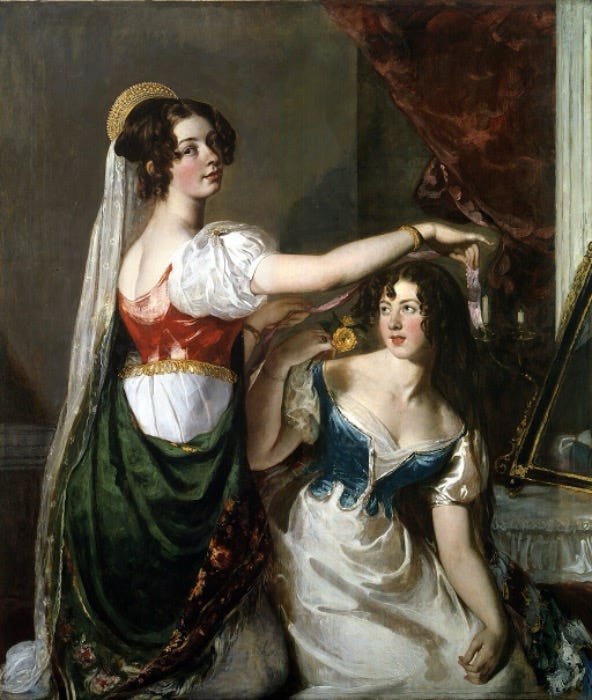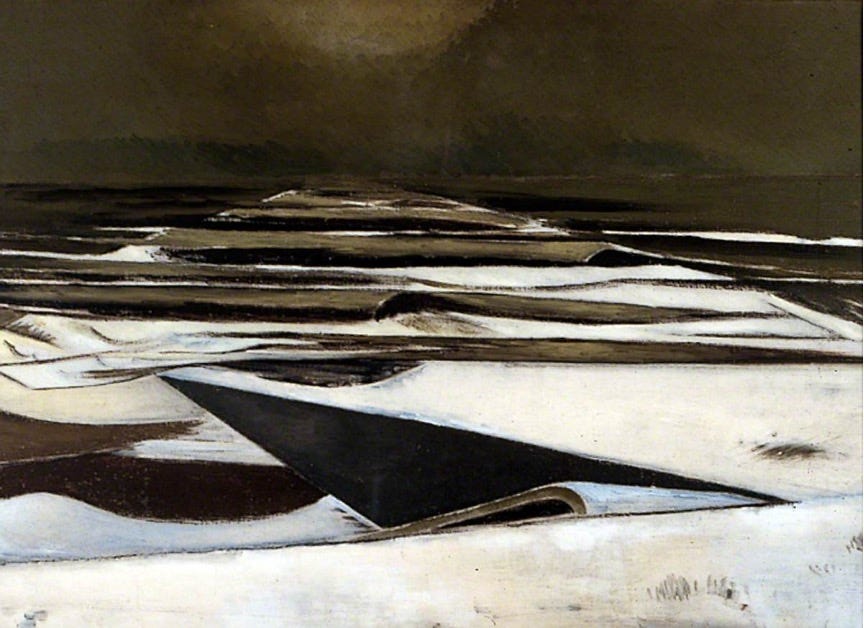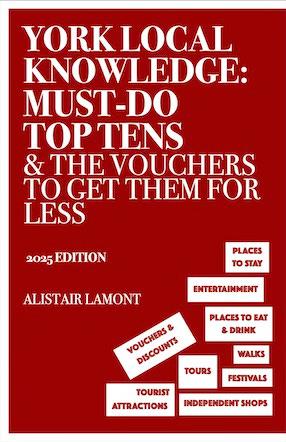York Art Gallery Curators guide to 10 of it's must-see artworks
From Miller to Lowry and a Grayson Perry glazed ceramic these are just some of the amazing works you can find at York Art Gallery
If you’ve just listened to our latest podcast on York Art Gallery and would like not know more (link here if you missed it), we’ve pulled together this handy little guide to York Art Gallery’s 10 must-see artworks.
Laurence Stephen Lowry, Clifford’s Tower, York, 1953, oil on canvas
The tradition of topography declined in about 1850 when photography offered a more accurate way to record a scene. In 1950 the Evelyn Award was established to bring York’s topographical collection up to date. This painting of the thirteenth-century Clifford’s Tower was the result of the 1952 commission of the Award. Lowry often used a white background and did not include shadows, giving his pictures a naïve and dreamlike quality. His paintings are best known for large crowds of “match-stick” figures, but this canvas is unusually sparsely populated. In the painting Lowry contrasts Clifford’s Tower with the modern cooling tower and chimney of the Foss Island power station on the right-hand side of the canvas. He creates visual echoes in the geometry of these structures and contrasts them again with the pointed spire of a church to the left of Clifford’s Tower. The power station was built in 1900 and decommissioned in 1976.
Harland Miller, York So Good They Named It Once, 2024, oil on canvas
This incredibly large and striking canvas is part of York-born artist and writer Harland Miller’s “Pelican Bad Weather Paintings” series. Reflecting on the meaning of the work, Miller remarks: ‘Some people have thought of it as straight down-the-line satire, comparing Olde York to New York. While of course it can be read that way, what I actually thought I was doing was riffing on the idea of York being the first York, way before New York, and in fact also the first capital – albeit under the Roman name of Eboracum.’ Miller generously gifted this work and two other paintings to York Art Gallery at the start of 2025. Visitors to York Art Gallery will be able to see all three of these works in the upstairs galleries. They will also be able to visit Harland Miller: XXX, an exciting exhibition featuring some of Miller’s newest works. This exhibition is located in the Madsen Galleries downstairs, and it runs until the 31st of August 2025.
Grayson Perry, Melanie, 2014, glazed ceramic
In 2003 Grayson Perry became the first potter to win the Turner Prize. Perry decorates his hand-built ceramics with imagery critiquing the injustices and hypocrisies of contemporary society. In 2014 Perry was filmed producing a series of portraits as part of the Channel 4 series ‘Who Are You?’. The portrait that York Art Gallery owns depicts Melanie, a contestant in the ‘Miss Plus Size International’ competition who Perry interviewed. Melanie forms one part of a three-piece portrait by Perry titled The Three Graces. Perry said of The Three Graces: ‘Three women stand big and proud, who want their size to be seen as a positive. I have portrayed them as vaguely antique hieratic adorned with images, old and new, of female ‘perfection’ and food. In the history of sculpture, female forms such as these were often seen as fertility goddesses to be prayed to for children and plentiful harvests. Nowadays we are more likely to see a growing health problem.’ Melanie’s stance echoes fertility figures such as the Venus of Willendorf, which were amongst the earliest modelled ceramics known, some dating back 11,000 years. With exaggerated breasts, hips and thighs, they are often shown without arms and having a small head with no facial features. Unlike these figures, Perry has given each of his ‘Graces’ faces, making them true portraits. Melanie is an important artwork as it represents a development in Perry’s practice, with the artist progressing from making more traditional ceramic vessel forms to producing more challenging figurative forms whilst still retaining his edgy narratives with connections to both historical and contemporary art and popular culture.
Laura Knight, Early Morning in a Gypsy Camp, 1953, oil on canvas
Laura Knight was among the most successful and popular painters in Britain during the twentieth century. Her success in the historically male-dominated British art establishment paved the way for greater status and recognition for female artists. In 1936 Knight became the third woman elected to full membership of the Royal Academy. Knight was known for painting amidst the world of the theatre and ballet in London, and for being a war artist during the Second World War. She was also greatly interested in, and inspired by, marginalised communities and individuals. Knight began to paint the everyday lives of traveller communities in 1933 at Iver Common in Buckinghamshire. She also made drawings, many of which she returned to in 1952 to incorporate into a study for Early Morning in a Gypsy Camp. Invited to the camp by resident Lilo Smith, Knight was made welcome and came to know the individuals in our painting intimately. She depicted them on numerous occasions: Beulah, the woman plaiting her hair to the right of the canvas, and Gilderoy, the naked boy in centre of the composition, feature in many portraits. Knight credits her time at Iver as one of her most inspiring life experiences, whilst acknowledging the struggles of the community: 'Although the mud of the road is their carpet, the sky is their ceiling'.
Frans Snyders, A Game Stall, 1625–35, oil on canvas
The sheer size of Snyders’s busy painting of dead game enhances the sense of overwhelming abundance. Snyders crams an astonishing variety of species into the scene, where live cats, dogs and cockerels intermingle with the carcasses of birds, deer and a bristly boar’s head. The prize item – a gleaming peacock – is held up by the stall boy. As well as a rare culinary delicacy, the peacock was also a symbol of eternal virtue, reminding us of the transience of sensual pleasures. You can spend hours looking at this enormous painting and spot something new every single time!
William Etty, Preparing for a Fancy Dress Ball, 1835, oil on canvas
The sculpture standing outside York Art Gallery is a monument to the York-born artist William Etty. He achieved fame during his lifetime for his history paintings which often contained nude figures. Etty was commissioned to paint this double portrait of Charlotte and Mary Williams-Wynn by their father the Hon. Charles Williams-Wynn MP, perhaps to mark Mary’s marriage, or to show off the unwed Charlotte to potential suitors. Costume balls were popular and fashionable events of the period and Etty uses the subject to show their high social standing. Charlotte, the eldest, here standing, went on to become a famous diarist and letter writer. Etty evidently took his time over the portrait, stating in a letter to their father that ‘your ladies should have been delighted to have had the last sitting’ and that he regretted that it had not been in his ‘power to render it less tedious’. Etty, however, defended the numerous sittings by claiming that ‘what is worth doing at all, is worth doing well’. When the painting was exhibited at the Royal Academy in 1835, commentators were impressed by the ‘graceful attitudes and tasteful costumes’ as well as the ‘pleased and intelligent countenances’ of the sisters.
Barbara Hepworth, Surgeon Waiting, 1948, oil and graphite on paper
Barbara Hepworth was born in Wakefield in 1903. This is one of a series of drawings she produced between 1947 and 1949 depicting surgeons and nurses preparing for or performing operations at the Princess Elizabeth Orthopaedic Hospital in Exeter. Each of the works presents two or three figures in a harmonious arrangement that is symbolic of their common purpose. Hepworth focuses on their hands and eyes, noting the intense concentration, precise movements and gestures required during surgery. Hepworth made sketches in the operating theatre using a sterilised notebook and pen and immediately worked up the images to finished pictures. As late as the 1940s surgeons began to focus on keeping the operating theatre clean and sterilised and this was when they began to wear antiseptic gowns. Surgeons also wore special hats to protect patients from germs carried in their hair. At the time of this drawing, Hepworth was starting to gain an international reputation as a sculptor. Even in her two-dimensional work, the keen interest in texture and sculptural form that preoccupied the St Ives artists is evident. The surgeon appears monumental yet there is a sense of movement achieved by the scratched surface.
Domenichino or Annibale Carracci, Monsignor Agucchi, 1603–1604, oil on canvas
This is undoubtedly one of the most important paintings in the collection of York Art Gallery. It is a sign of this that during the Gallery’s major refurbishment it was put on show in the National Gallery in London instead. For a brief period, it had been in the possession of Kenneth Clark, for a period Director of the National Gallery, a person who knew a good picture when he saw one. For most of its history the work was thought to be by Domenichino, but since the 1990s it has been debated whether it should be attributed to Annibale Carracci instead, largely on stylistic grounds. Whether by Domenichino or Carrracci the portrait of Agucchi is certainly a work of Bolognese School, which produced a series of celebrated masters in the late sixteenth and early seventeenth centuries. The sitter in the painting is Giovanni Battista Agucchi, a nobleman born in Bologna in 1570 who went on to become secretary to Pope Gregory XV. The paper he holds in this portrait might refer to his position as secretary to the Pope. The art historian Tomaso Montanari identifies in the portrait of Agucchi one of the first examples of a talking portrait: that is the type of portrait, typically Baroque, in which the portrayed is placed in direct relationship and personal with the observer, to the point that he seems to be about to speak to him.
Paul Nash, Winter Sea, 1925–37, oil on canvas
Paul Nash created this painting in Dymchurch in Kent, where he had retreated to recuperate after his formative stint as an official war artist during the First World War. Nash was influenced by Cézanne, Cubism, and Surrealism. Sombre in colour, the waves in this painting are reduced to geometric shapes, emphasising the forbidding nature of the sea. The repeated forms lull the viewer as the repetitive motion of real waves can do. The bleakness of this painting is informed by Nash’s experience in the First World War. Nash had initially been a soldier and was injured, falling into a trench. On his recovery, he returned to the front as a war artist. The claggy, mud-coloured sky of Winter Sea evokes the power of Nash’s war landscapes. It is easy to read this image as the path to war in Europe, which in 1937, had begun to seem inevitable.
Gwen John, Young Woman in a Red Shawl, 1917–23, oil on canvas
Gwen John studied at the Slade School of Art, the only art school in the United Kingdom in the nineteenth century that allowed female students. In 1898 John made her first visit to Paris with two friends from the Slade, and while there she studied under James McNeill Whistler at his school, Académie Carmen. This painting was produced in Meudon, a suburb of Paris, where John had settled in 1904. John produced over fifty pictures showing the unknown model who appears in this study. This restrained painting, executed in a narrow and subtle range of colours, is typical of her work. John was little known in her lifetime because she lived quietly and was reluctant to exhibit her paintings; moreover, she was overshadowed by her artist brother, the flamboyant Augustus John, and her lover, the French sculptor Auguste Rodin. However, today Gwen John’s paintings are probably better-known than her brother’s and more admired.
Want to read more for your next visit to York?
Then download a free copy of our book York Local Knowledge Must-do Top Tens & the vouchers to get them for less where you will discover the historic UK city of York like a local with tips, top tens, and guidance on where to find the best discounts and vouchers, so you can experience it all without breaking the bank!
You can download it for free from the Apple iBooks Store here
You can download it for free from the Google Play Books Store here
This isn’t your average guidebook—it’s a laugh-out-loud, down-to-earth companion, packed with top-ten lists covering everything from essential attractions and hidden gems to entertainment, dining spots, walks, tours, festivals, and shopping, all enriched with a local’s insider knowledge.
With insights, amusing anecdotes, and a sprinkling of puns and dad jokes, Alistair’s love letter to York will help you see the city in a whole new way. Grab a copy and start planning the York adventure you didn’t know you were missing!
With over 240 pages, this guide is ideal for families and groups of friends planning a trip to York and includes:
Up-to-date information on everything in the ever-changing city of York—this is the 2025 edition.
Top ten lists of York’s best tourist attractions, entertainment spots, food and drink, walks, tours, festivals, and independent shops.
Beautiful photography accompanying every recommendation.
Answers to visitors’ top questions, from “Where’s the best place for ice cream?” to “Where can I find a great takeaway curry?”
Recommendations on where locals go for up-to-date information about York.
The best places to stay, from five-star hotels to holiday homes and houseboats.
Details on where to find discounts and vouchers for York restaurants, attractions, and experiences.
Want to hear a great podcast about York?
A fab podcast for tourists and locals looking to find out more about York History, must do York Top 10's and money saving tips to do it all for less.
Just search your podcast app for York Must Do Top 10s or click on this link for the show on apple podcast here
Book one of our Holiday Homes for your next trip to York
Are you looking for a great place to stay for your next trip to York. All 3 of our holiday homes are next door to each other which means you can hire them individually for up to 6 people or together for up to 12 (107 & 109 together) or even 18 people (Spencer House & 107 & 109 together).
To check availability and book just visit www.houseofyork.org
We pride ourselves on being couples and family friendly and we try to take any of the stress out of your stay so you can focus on enjoying yourselves and magnificent York.



